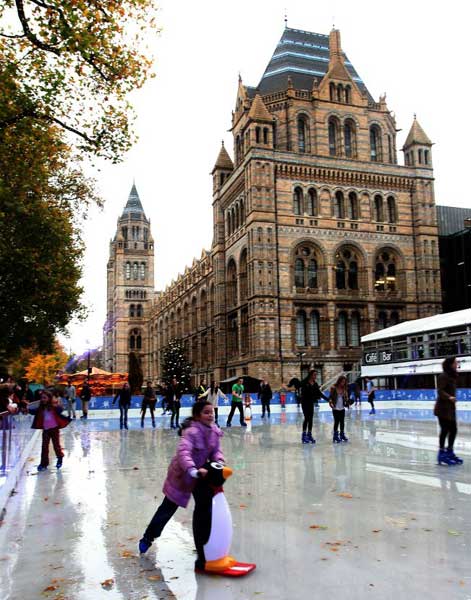Slippery customers: It's the season for outdoor ice rinks but how are they engineered?

When the great Thames is frozen on the northside," wrote Archdeacon William Fitzstephen in 1190, "young men have taken to tying bones to their feet ... and do slide as swiftly as birds on its glassy surface." Although medieval prelates may have found such things surprising, today ice rinks are as much part of Christmas as mulled wine, turkey and 5am queues outside Hamleys. But while the sight of people skating is no longer noteworthy, one thing remains a mystery to many: how you actually build one? How do you set up, maintain and take down an outdoor ice rink?
The answer lies closer to home than you might think – in your kitchen to be exact. "Ice rinks are quite similar to fridge-freezers," explains Marc White of Carrier Rental Systems, the firm that creates some of the capital's biggest rinks. "Like your home fridge, they work by constantly moving a coolant a round a tightly-wound system of pipes, which cool the area adjacent to them." The coolant system, which is made of flexible 1cm diameter pipes, is laid on a perfectly flat base of wood and polyester (the polyester prevents ground heat melting the ice). An external pump then pushes a mix of water and antifreeze into the pipes. Despite being chilled to -10C, the antifreeze prevents the water solidifying, which is essential if the ice surface is to be the same depth all over. Once the pipes are at the desired temperature, the rink is ready to be covered in the water that will form the skating surface.
"To ensure the ice is the correct thickness, we have to flood the surface slowly," says White. "It takes a couple of days to get the flat, 1cm-thick surface the public skates on, and it's an incredibly laborious process." Laborious as it may be, it is also vital. If the ice is too thick, it will require vast amounts of energy to maintain; if too thin, it will crack. However, the quantity of water involved makes this logistically difficult. The rink outside the Natural History Museum in London is 900sq m and requires 80,000l of water (that's 4,500 buckets) to keep it ticking over, so drawing enough water requires planning with water companies. The real problem, though, is beyond the control of rink operators and water companies.
"The sun is the major difficulty," says White. "On a clear winter's day it can increase the temperature to such an extent that the top ice melts, and then you have everyone falling over." To ensure broken bones are kept to a minimum, the rink's operator monitors the ice's temperature by using electronic sensors in its surface. If the temperature rises, the rink manager reduces the temperature of the coolant by a degree or two to refreeze the surface ice. This is a rolling process and requires the watchful eye of an engineer and sufficient electricity to change the temperature of the coolant quickly. So it is, as White says, "incredibly time consuming and expensive".
Mercifully, deconstruction is much simpler than construction. The operator increases the temperature in the pipes under the ice, which melts the surface ice. This is done slowly, to avoid flooding the surrounding area, several tankers suck off the melted water. Once the ice is gone, the wood and polyester bottom is deconstructed like a giant Meccano set. A rink the size of the one outside the Natural History Museum takes about 2,000 man hours to construct and deconstruct. So next time you take a tumble on the ice, don't curse the uneven ice or a slushy surface. Be grateful that you get to do it at all.
Subscribe to Independent Premium to bookmark this article
Want to bookmark your favourite articles and stories to read or reference later? Start your Independent Premium subscription today.

Join our commenting forum
Join thought-provoking conversations, follow other Independent readers and see their replies